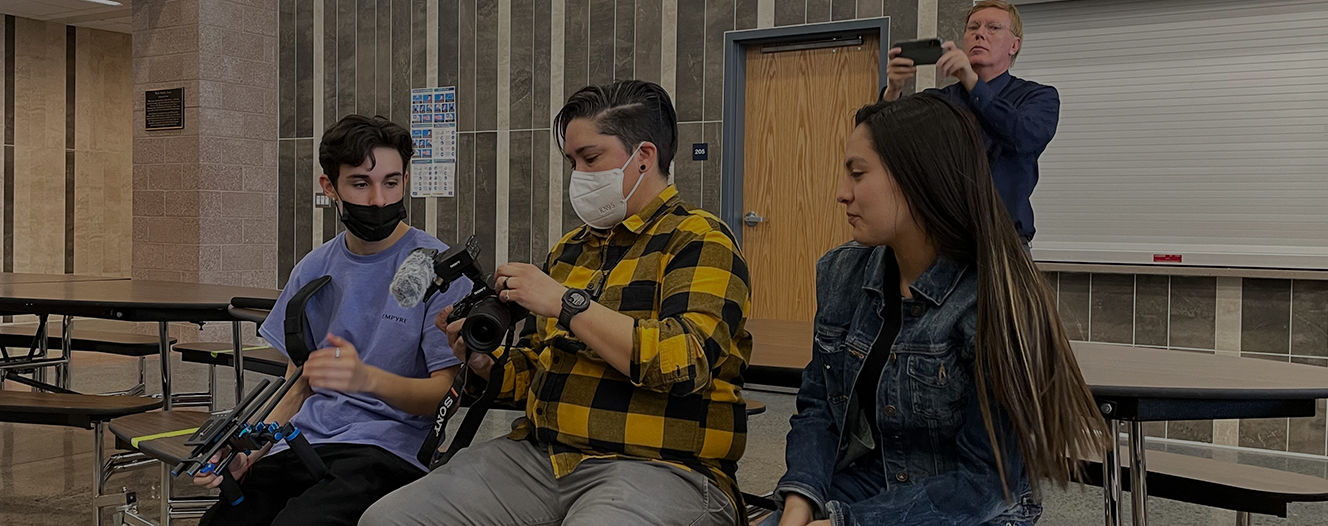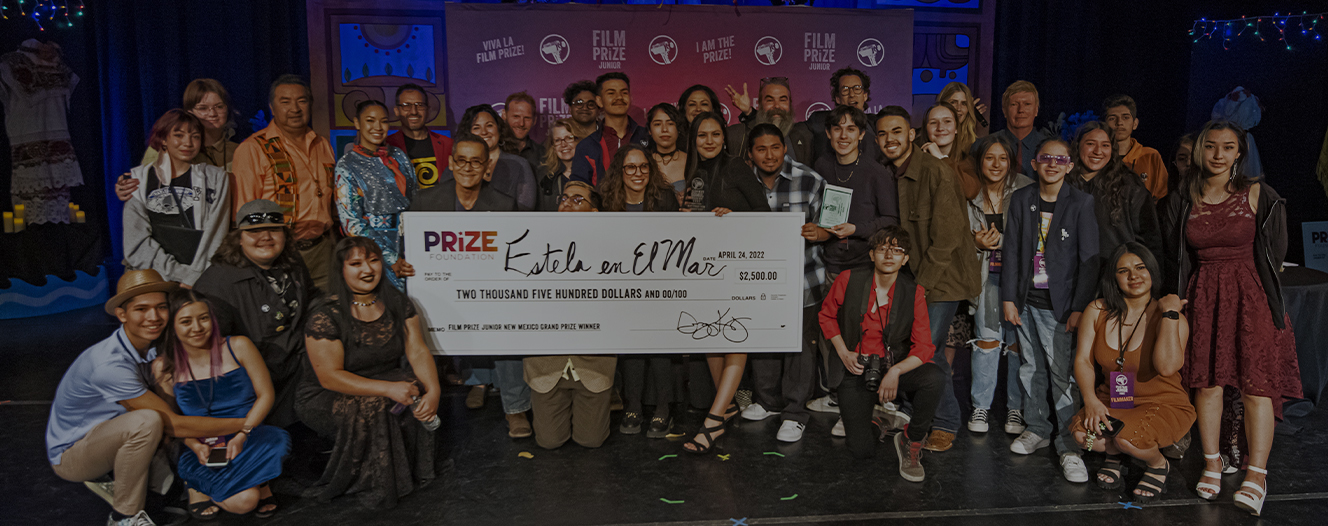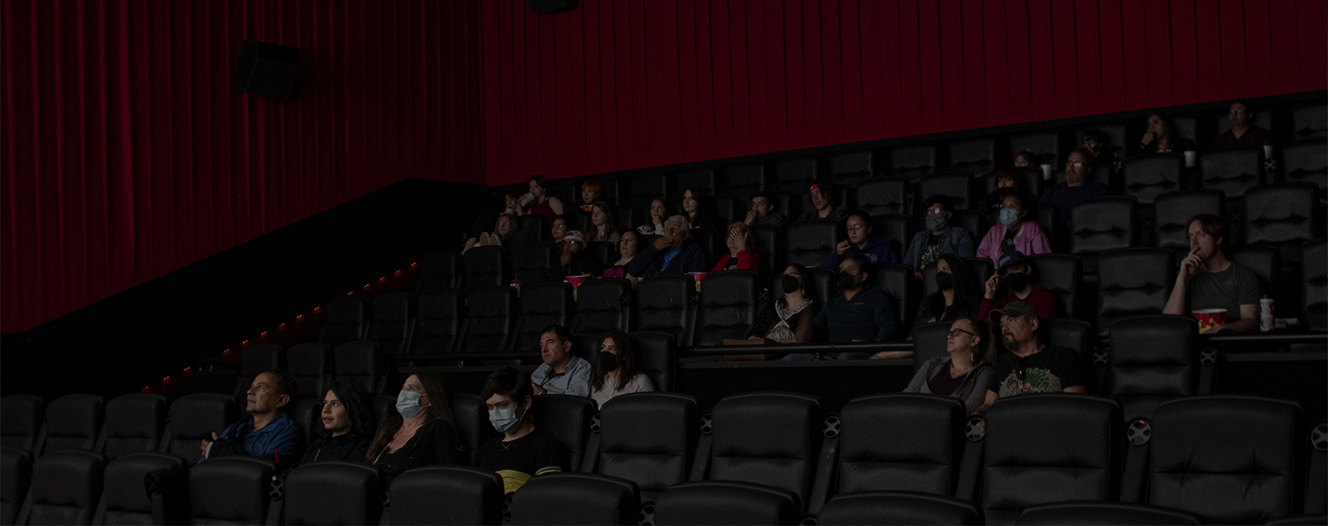2024 FILM PRIZE JUNIOR FESTIVAL DEADLINES
REGISTRATIONS for 2024 FILM PRIZE JUNIOR FILM FESTIVAL due by
Sunday, December 17th, 2023 – 11:59 PM MT
PROOF of FILM CONCEPT for FESTIVAL ENTRIES due by
Monday, November 30th, 2023 – 11:59 PM MT
FINAL CUTS and PRESS KIT SUBMISSIONS due by
Tuesday, March 5th, 2024 – 11:59 PM MT
2024 FILM PRIZE JUNIOR FILM FESTIVAL
Saturday, April 6th, 2024 (Festival)
Sunday, April 7th, 2024 (Awards Ceremony)
2024 FESTIVAL ENTRY REQUIREMENTS
Published September 29, 2023
There are three phases of entry to compete in the Film Prize Junior Film Festival: REGISTRATION, PROOF of FILM CONCEPT SUBMISSION, and FINAL CUT & PRESS KIT SUBMISSION. Each step must be completed for each entry to determine points of contact and responsible parties, to communicate updates and availability of resources and training sessions AND to track production progress as assets are produced and completed through the process.
To compete in the 2024 Film Prize Junior Film Festival, please review the requirements for each phase as specified below:
REGISTRATION REQUIREMENTS
- REGISTRATION confirms entry to compete in the 2024 Film Prize Junior Film Festival.
- At the time of REGISTRATION, each entry must designate the Teacher Sponsor, Student Lead and Organization responsible for completing tasks required for our competition.
Filmmaker
- A Filmmaker, as defined by Film Prize Junior, is any student or teacher who contributes ideas and efforts to production of a short film for the Film Prize Junior Film Festival.
- While the Teacher Sponsor, Student Lead and Film Crew members affiliated with an entry are all considered Filmmakers, the Student Lead and Film Crew are considered Student Filmmakers.
Teacher Sponsor
- A Teacher Sponsor is an educator or administrator employed by an Organization (see below) assigned with managing a Film Prize Junior Festival entry.
- A Teacher Sponsor is responsible for providing progress updates regarding their students’ entry and communicating news, deadlines and resource provisions to their Student Lead(s) and Film Crew.
- A Teacher Sponsor can be assigned to more than one entry for Film Prize Junior.
- See note under Restrictions >> Organizations – School or Program
- Changes in Teacher Sponsor after REGISTRATION should be communicated immediately to Film Prize Junior administration to be updated accordingly.
- A Teacher Sponsor can teach any subject and is not required to have any prior filmmaking experience to compete in our festival. (That’s our job!)
Student Filmmaker, Student Lead & Film Crew
- Student Filmmakers are principally responsible for contributing efforts and ideas to creating a short film to enter for the Film Prize Junior Film Festival. These efforts include story development, pre-production, production, post-production and promotion of the film.
- As Student Filmmakers operate under the management of their Teacher Sponsor, the Teacher Sponsor may provide guidance and facilitate learning and development of the skills mentioned above by way of demonstration or coaching (e.g. a teacher showing students how to use functions on a camera). However, Student Filmmakers will be expected to lead filmmaking efforts for their entry.
- A Film Crew is one or more Student Filmmakers who collaborate with their Teacher Sponsor to produce an entry for the Film Prize Junior Film Festival.
- Members of a Film Crew can have many roles, including director, writer, editor, producer, set designer, cast member, and so on (i.e. any position operated or created in any part of the filmmaking process for the purpose of making a film, including writing, pre-production, production, post-production, and promotion).
- Any number of students can participate as members of a Film Crew for an entry. HOWEVER, one Student Filmmaker from the Film Crew must be chosen to represent the entry as the Student Lead.
- The Student Lead is responsible for overseeing the creation, production and execution of the festival entry alongside their Teacher Sponsor and works in tandem with their Teacher Sponsor and Film Crew. The Student Lead should be thought of as a Producer of their short film.
- Any member of the Film Crew qualifies as long as they are enrolled in the Organization that employs the Teacher Sponsor affiliated with their festival entry.
- See note under Restrictions >> Organizations – School or Program
- The Teacher Sponsor is responsible for selecting the Student Lead from the Film Crew of their festival entry. Film Prize Junior does not enforce any academic eligibility requirements for students participating in our competition,
- All student members of a Film Crew must be enrolled in a School (see below) at any grade level from 5th through 12th grade.
- Students can work on multiple festival entries either as a Student Lead or as a member of a Film Crew, BUT to participate in our competition, students must be permitted at the discretion of the Teacher Sponsor affiliated with that entry.
- If a student wants to participate in Film Prize Junior but is unable to find a willing Teacher Sponsor at their School of enrollment, they can seek out a Teacher Sponsor from a Program with which they are both affiliated. (See below)
- Film Prize Junior does not enforce any academic eligibility requirements for students participating in our competition.
- No students are required to have any filmmaking or leadership experience prior to participation in our competition. (That’s our job!)
Organization
- An Organization is an entity that hosts an entry for the Film Prize Junior Film Festival.
- An Organization is responsible for establishing pathways for communication and learning between the Teacher Sponsor and Student Filmmakers affiliated with a festival entry. An Organization must be both a source of employment for the Teacher Sponsor and a source of enrollment for the Student Filmmakers affiliated with a festival entry.
- Changes in Organization after REGISTRATION should be communicated immediately to Film Prize Junior administration to be updated accordingly.
- For awards purposes, all entries must designate whether the affiliated Organization is a School or a Program.
- A School is an Organization accredited by the state department of education with a site based in-state such as a public school, private school, or charter school OR any homeschool group offering comparable education.
- A Program is an extra-curricular Organization that does NOT seek accreditation by the state department of education and functions independently of a school or accredited institution. Examples of a Program, as defined by our competition, include theater troupes, nonprofit associations, professional interest or job training initiatives, academic assistance cooperative, regional or neighborhood after school operations, and so on.
- All entries registered under a Program must designate both a School Beneficiary and a School Liaison.
- The School Beneficiary benefits from any film equipment grants awarded to a Program‘s festival entry.
- The School Liaison is employed by the School Beneficiary and is responsible for providing necessary documentation to receive festival equipment grants or other monetary awards earned by a Program‘s festival entry.
- If no School Beneficiary is elected by the FINAL CUT SUBMISSION deadline, this role will default to the Student Lead’s current school of enrollment.
- Film Prize Junior will only accept a maximum of five (5) short film submissions from any School competing in the festival.
- NOTE: A Teacher Sponsor can register any number of festival entries from an Organization so long as that number of entries does not exceed the allowable maximum from that School.
- For any and all short film entries registered from a Program, no School can be designated as School Beneficiary if they already exceed the maximum allowable number of festival entries for that School.
- A Teacher Sponsor can register any number of festival entries from an Organization. HOWEVER, if more than five films are yielded from these registrations, the affiliated Organization, Teacher Sponsor(s) and Student Lead(s) are responsible for determining which short films will be submitted so as not to exceed the allowable maximum.
- Any and all entries to the Film Prize Junior Film Festival must be produced in entirety within the state hosting the competition.
- Any and all festival entries must be submitted as either a Middle School (5th – 8th Grade) or High School (9th – 12th) film to qualify for screening and awards.
- If an entry is registered from an Organization that spans across these designated divisions of middle and high school grades, we suggest basing the entry’s division on the grade of the affiliated Student Lead. This decision is up to the determination of the Teacher Sponsor and Film Crew, but they should be prepared to justify their decision in case of inquiry.
- No Organizations (including Schools and Programs) are required to provide film-focused education or resources prior to REGISTRATION with Film Prize Junior prior to participating in our competition. (That’s our job!)
For this year’s competition, the Teacher Sponsor will initiate the registration process at FILMPRIZENM.com/portal. Our team will create an account for each teacher sponsor in our new Filmmaker Portal that will house all current and past educational resources as well as a track for teacher sponsors and their student filmmakers to complete and track their progress in our festival. Information about new Filmmaker Portal coming soon.
Notes on Surveys, Privacy & Communications
- Our competition is free to enter for all interested and eligible participants. As such, we ask that participants complete requested surveys both to develop programming that best supports the needs of our filmmakers and to demonstrate the value of our programming to funders who help keep our program free.
- In compliance with federal regulations regarding student privacy protection, we request information be provided by our Teacher Sponsors and their Organizations. Our team will only direct communication regarding an entry with the affiliated Teacher Sponsor. We will only communicate with Student Filmmakers in the presence of their Teacher Sponsor.
- We do not require students to provide protected personal information (PPI) to participate in our program.
PROOF OF FILM CONCEPT REQUIREMENTS
- A PROOF OF FILM CONCEPT, hereby referred to as a PROOF, documents the plans and intentions of a festival entry provided by the affiliated FIlmmakers (i.e. the Teacher Sponsor, Student Lead and Film Crew). All entries are required to prepare and submit a PROOF prior to submitting a FINAL CUT & PRESS KIT to compete in our festival.
- A PROOF prepares the Teacher Sponsor, Student Lead and Film Crew to produce and submit a FINAL CUT of their festival entry for the Film Prize Junior Film Festival.
- To be eligible to compete in the festival, all content included in a PROOF must adhere to our RULES & GUIDELINES for FILM CONTENT (See here).
- A PROOF includes any and all documents assembled to prepare for production. Filmmakers are required to specify the form(s) of PROOF they submit. Film Prize Junior accepts many forms of PROOF, including but not limited to the following:
- Screenplay — Also known as a script, a screenplay is a written work for film, television or other media that expresses the movement, actions and dialogue of characters in a story. A screenplay is the blueprint of a production and is written in a specific format to distinguish between characters, action lines, and dialogue.
- Film Treatment — A film treatment is a brief summary of a production for film, television or other media. A film treatment should communicate all scenes and themes essential to the concept as well as the concept’s tone. Film treatments are also referred to as story treatments, script treatments, and movie treatments.
- Storyboard — A storyboard is a visual representation of a film sequence that breaks down action into individual panels. A storyboard usually features a series of ordered drawings accompanied by camera direction, dialogue or other pertinent details. A storyboard sketches out how a video will unfold shot-by-shot, laid out in a comic format.
- Shot List — A shot list is a document that maps out everything that will happen in a production of film, television or media scene-by-scene with a description of each shot. Serving as a checklist, it provides direction and preparedness for the film crew
- Upon submission of a PROOF for a festival entry, the Film Crew must also provide the following:
- A working (i.e. “not final, temporary”) GENRE and TECHNIQUE of the entry (see below);
- A synopsis (i.e. a brief description) of the film concept; and
- The goal in sharing the film concept at the festival (i.e. the message you want your audience to take away after seeing the completed film).
Review & Approval
- Upon submission, each PROOF will be reviewed by the Film Prize Junior Concept Review Team to determine whether the concept meets the festival’s RULES & GUIDELINES for FILM CONTENT.
- Note: We encourage filmmakers to provide ample documentation with their PROOF upon submission. Our team will only have what you provide to understand your film concept – so be sure to cover any details you hope to include to achieve the vision for your film (e.g. camera angles, a prop list, sounds, resource needs, animation styles, etc.).
- The Concept Review Team consists of administrative members of Film Prize Junior as well as rotating Film Mentors – professional filmmakers who lend support and expertise to help Student Filmmakers learn and grow.
- As the Concept Review Team reviews a PROOF for a festival entry, they will provide constructive feedback on Formatting & Clarity, Narrative & Creativity, Characters & References, and Scope of Production. We also look for Red Flags to determine any obstacles to production (See RULES & GUIDELINES FOR FILM CONTENT).
- The primary objective of the Concept Review Team is to provide feedback that will improve the producibility and the likelihood of completed production. If a Film Crew has any concerns about the feedback provided for their PROOF, the Teacher Sponsor should reach out directly to our administrative team.
- Neither a festival entry’s PROOF nor the feedback provided for the PROOF by the Concept Review Team at the time of submission will affect an entry’s placement in our competition. Our panel of Film Mentor Judges is curated externally from the Concept Review Team, and their judgements are based solely on the content of the FINAL CUT submission for that festival entry.
- Upon review, the Concept Review Team will determine if a festival entry is approved for production based on the affiliated PROOF. If the entry is granted production approval, the Film Crew may proceed with planning and executing of the concept.
- If the Concept Review Team determines that an entry cannot be approved for production based on the PROOF submitted, the Film Crew affiliated with that entry is responsible for making any and all requested changes AND producing any requested documentation BEFORE beginning production for the festival entry.
- All PROOFS must receive approval from the Film Prize Junior team before Filmmakers proceed to production of the entry.
- If a festival entry is not immediately granted production approval upon the first review, do NOT give up on your film! Obstacles to production are the only determining factor of concept approval. Once all requested revisions are made, resubmit PROOF for approval. Critique is an important part of the filmmaking process, and our team only provides feedback to improve the likelihood of your Film Crew completing film production.
- Any changes to the short film concept made after PROOF approval must be communicated with the Film Prize Junior team BEFORE production is completed and FINAL CUT is submitted. An updated PROOF may be requested from the Film Crew before granting approval to ensure that the new concept adheres to our RULES & GUIDELINES FOR FILM CONTENT.
FINAL CUT REQUIREMENTS
- Upon a festival entry being granted production approval, the Film Crew must submit both a FINAL CUT and a PRESS KIT for the festival entry.
- The FINAL CUT results from the combined efforts of an entry’s affiliated Filmmakers (i.e. Teacher Sponsor, the Student Lead, the Film Crew and the Organization) to complete production of a festival entry from REGISTRATION as indicated by the PROOF OF FILM CONCEPT.
- The FINAL CUT as submitted for entry will screen both virtually on the Film Prize Junior website and in-person at the Film Prize Junior Film Festival as long as the content abides by our rules and is submitted through our Filmmaker Portal.
The FINAL CUT of the festival entry must be submitted as follows:
- One (1) fully rendered video file no larger than 10 GB that will be ready to screen at the virtual and in-person festivals
- Video Encoding – H.264 or Apple Prores 422 HQ (Recommended if available)
- Most professional video editing software provides video encoding during export. This can reduce your export file size without reducing the quality of your FINAL CUT (Learn more about this here).
- File Type – .MP4 is preferred, but .MOV, .WMV, and .AVI are accepted as well.
- Aspect Ratio – Widescreen Format (16:9) for landscape viewing
- Any entries submitted with a different aspect ratio will be scaled to fit within a 16:9 aspect ratio with black to fill in negative space.
- Entries produced entirely in portrait orientation will not be accepted.
- Resolution – 1080p or 720p
- Frame Rate – 24 (23.976) or 30 (29.97) frames per second
- NOTE: These settings are recommended to maintain reasonable file sizes during export. Filmmakers should avoid providing files in higher quality (e.g. 4K resolution or 60 FPS) to reduce likelihood of larger files that could slow down export and upload. Check here for other file size management tips.
- Language – Entries submitted with spoken dialogue in languages other than English must include English subtitles or closed captions to translate the dialogue.
With consideration for the inclusive nature of our festival and the curation of viewing slates ahead of festival screenings, all entries must abide by the following content restrictions regarding time constraints and credits:
- The FINAL CUT of each festival entry excluding closing credits must fall between 3 and 10 minutes for live-action films and 1 and 6 minutes for animated films.
- Each entry is required to provide the total runtime length of the FINAL CUT both before AND after closing credits in minutes and seconds.
- For example, if a film is 8 minutes long with the last 20 seconds being closing credits, your runtime before credits would be 7:40 and your runtime including credits would be 8:00.
- Each festival entry MUST include Closing Credits that are no longer than 30 seconds in their FINAL CUT.
- Closing Credits should include the director, writer, cinematographer, editor, cast (in order of appearance) and crew (specify roles where possible) as well as the producers – the Student Lead, the Teacher Sponsor and the Organization affiliated with the entry.
- Student Filmmakers credited in the FINAL CUT should be listed by first name and last name initial.
- Each entry must include a Title Card in the first 10 seconds of the FINAL CUT to indicate the title of the short film to the audience during festival screenings.
- The Title Card can be as simple as a black screen with the title in white type, and it should be no longer than 5 seconds.
- Opening Credits are NOT required. Should they be included, they must play in the first 10 seconds of the FINAL CUT, and they cannot exceed that time.
- Bloopers may be included ONLY if they play concurrently with the Closing Credits and do not exceed the 30 seconds allotted for Closing Credits.
- Each entry will be screened and edited for quality control ahead of the in-person and virtual festivals to ensure all films are presented at the same standard for visual and sound quality.
- For in-person festival screenings, our team will consider which entries have been submitted from the same Organization during slate curation.
- For virtual festival screenings, each entry will be appended with a sponsor reel to thank the sponsors for this year’s program. The sponsor reel will be added after quality control is completed, and it will be added after each film’s closing credits.
- The Film Prize Junior team reserves the right to edit content as necessary with regards to time and format, including but not limited to the following examples: display aspect ratio, opening credits, closing credits, sound quality, resolution, inclusion of title cards, etc.
- The Teacher Sponsor affiliated with a festival entry will be informed by the Film Prize Junior team of any specific edits to their entry’s FINAL CUT ahead of festival screenings.
PRESS KIT REQUIREMENTS
- Along with the FINAL CUT, Filmmakers are required to submit a PRESS KIT for their festival entry. A PRESS KIT is a collection of assets and information produced by an entry’s Film Crew to promote and publicize the release and distribution of their short film ahead of festival screenings.
- Assets provided by Filmmakers for their PRESS KIT will be utilized to produce a landing page to facilitate promotion of their entry during the festival. These landing pages will be available to view on our website for the following year until the beginning of the next festival.
The following assets are requested to assemble the PRESS KIT for each festival entry:
- Film Title (Required)
- All entries must provide a film title to represent the film at the festival.
- Each film title must be unique to other entries for that state’s festival that year. If multiple entries share the same title, the first entry to complete requested submissions through the Filmmaker Portal will reserve the right to use the title for that festival, and subsequent entries will be asked to provide an alternate.
- Film Genre and Technique (Required)
- Each entry must designate the genre of their film from the five available for our festival (Comedy, Drama, Sci-Fi/Fantasy, Thriller, Documentary)
- Each entry must designate the technique of their film as either Live-Action or Animation.
- See GENRE & TECHNIQUE
- Film Log Line (Required)
- Each entry must provide a logline of 50 words or less to represent their short film. (Don’t know how to write a logline? Learn how here.)
- Film Credits (Required)
- Each entry must provide the names of students (First Name and Last Initial) who participated in their short film as Director, Writer, Cinematographer, Editor, Cast, Crew and Producers (Student Lead, Teacher Sponsor, and Organization).
- Filmmaker Interview (Required)
- Each Film Crew must provide written responses via the Filmmaker Portal to prompts provided by Film Prize Junior about the entry based on the collective experiences of the Film Crew responsible for its production. Those questions include the following:
- Tell us about this short film.
- Tell us about a scene you had an absolute blast filming.
- What is your goal in sharing your film with our festival?
- What obstacles challenged you and your Film Crew the most when completing this film?
- What did you learn from making this short film?
- Why are opportunities like Film Prize Junior important to students today?
- What advice would you give to future participants in Film Prize Junior?
- As with the other assets in the Press Kit, your Film Crew’s responses to these questions will be shared with your entry’s page on our website, so prepare well-thought responses that best represent your short film as well as your Teacher Sponsor and Organization.
- Each Film Crew must provide written responses via the Filmmaker Portal to prompts provided by Film Prize Junior about the entry based on the collective experiences of the Film Crew responsible for its production. Those questions include the following:
- Movie poster (Optional)
- 27” x 40” – (972p x 1440p) – portrait oriented, 1 MB MAX
- JPG or PNG
- Film Stills (Optional)
- One still frame from the FINAL CUT of the festival entry
- 1920p x 1080p for WideScreen Format, 1440p x 1080p for Standard Format
- Film stills will be published to fit a 16:9 aspect ratio.
- JPG or PNG
- Behind the Scenes Photos (Optional)
- Five (5) total pictures taken on set during film production
- Consider taking lots of pictures during production so your BTS photos are varied and highlight different aspects of your entry.
- Each image should be no larger than 1 MB
- JPG or PNG
- Five (5) total pictures taken on set during film production
- Note: While not all assets requested for a PRESS KIT are required for each festival entry, use of these assets by the Film Crew is an important part of the promotional process when producing a film and can greatly improve a film’s performance in our festival.
If Filmmakers complete all requirements for their festival entry as requested in the Filmmaker Portal and the content of their entry adheres to the RULES & GUIDELINES for FILM CONTENT, the entry and its filmmakers qualify as Finalists. Finalists are eligible to screen their short films at our in-person festival with filmmakers from around the state, and their film will be available to stream on our site for the following year. All Finalists are eligible to compete for awards, grants and scholarships to celebrate efforts and encourage development of their skills.
RULES & GUIDELINES FOR FILM CONTENT
For each festival entry to qualify as a finalist in our festival, the Teacher Sponsor and Film Crew must submit a PROOF OF FILM CONCEPT that documents the plans and intentions for their short film. You can learn more about the review process under 2024 Festival Requirements.
The Film Prize Junior team designed the following RULES & GUIDELINES to guide filmmakers through the filmmaking process and to keep production safe and legal for all participants of Film Prize Junior. To qualify as a finalist, concepts for each festival entry must adhere to the following terms:
GENRE & TECHNIQUE
Film submissions to our festival have the latitude to cover a wide array of subjects as long as they fall within our RULES & GUIDELINES; however, every film must be submitted under one of the following Genres at the time of submission:
- Comedy – work of fiction consisting of jokes or satirical elements intended to inspire laughter and joy
- Drama – work of fiction consisting of conflict among characters intended to evoke thought or feeling
- Thriller – work of fiction consisting of suspense and mystery intended to build intrigue, interest, or fright
- Sci-Fi/Fantasy – work of fiction depicting the impact of real or imagined science OR work of fiction depicting an alternate reality inspired by myth or folklore
- Documentary – work of nonfiction consisting of documentation, records and interviews intended to educate on a chosen topic
Film submissions to our festival must indicate a Technique from the options below at the time of submission:
- Live-Action – a film submission composed of video recording of still or moving objects (must be 3 to 10 minutes in length before closing credits)
- Animation – a film submission composed of elements such as stop-motion, claymation, frame animation, computer generated imagery (CGI), puppetry or any other visual style of film that creates the illusion of movement when shown as a sequence (must be 1 to 6 minutes in length before closing credits)
While not required, if a Live-Action film includes elements of Animation, the Film Crew responsible may submit the film under the Animation technique ONLY under the following conditions:
- The elements of animation included in a Live-Action film must have been created or rendered by students in the Film Crew of the affiliated entry (i.e. no stock assets or assets rendered through third-party sites such as Animaker).
- The elements of animation included in a Live-Action film must be on screen for at least 50% of the film’s total runtime before closing credits.
- Visual Effects (as defined below) do not qualify as elements of animation in a Live-Action film unless the conditions above are met.
- Visual Effects (VFX) is the process in post-production where assets produced outside the scope of a film’s production are later integrated to enhance the impact of the film’s narrative.
- VFX includes CGI, motion capture and compositing.
LANGUAGE & THEME
- NO slurs, language or gestures that target or belittle any class of people (including regards to race, sexual orientation, gender identity or expression, ethnicity, nationality, or any other axis of individual or group identity) can be included in film submissions to this festival.
- NO profanity can be included in film submissions to this festival.
- NO sex or nudity can be included in film submissions to this festival.
- Religious ideas can be engaged and can be included in film submissions to this festival as long as the intent is neither to proselytize nor to disparage.
- Abuse (physical, emotional, or sexual) can be implied, suggested, and discussed in a sensitive manner with clear educational intent, but otherwise CANNOT be depicted in film submissions to this festival.
- Mental health struggles can similarly be referenced if presented sensitively with an intent to educate and inform viewers. HOWEVER, any acts of harming one’s self or others (e.g. cutting, purging, abuse, etc.) CANNOT be depicted in film submissions to this festival.
VIOLENCE, DRUGS & BODILY HARM
- Producing unsafe scenarios for film is both dangerous and illegal. Filmmakers cannot break any local, state or federal laws in the name of a short film entry to this festival.
- NO sexual violence can be depicted in any short film submissions to this festival.
- NO gratuitous blood or gore resulting from violence or trauma (physical, psychological, or otherwise) may be depicted.
- NO lethal weapons of any kind may be depicted WITHOUT approval of the Film Prize Junior team.
- Lethal weapons include but are not limited to guns, swords, knives, axes, nunchucks, ninja stars, grenades, bombs, rockets, missiles, and any object which appears capable of inducing bodily harm either on or off screen.
- Any and all props that appear lethal MUST BE APPROVED by the Film Prize Junior team prior to production. Props that act as weapons must not present any obvious threat or danger to the safety and wellbeing of any participants. Use of toy weapons to simulate lethal weapons is NOT permitted if the toy weapons appear realistic or lethal to the audience.
- For example, a green water gun or rubber chicken does not present an obvious threat or danger, but a rifle or steel sword does.
- NO illicit drug use or abuse can be depicted in a film submission
- This includes use of drugs (real or fictional) to alter a character’s perception for the purpose of abuse or manipulation.
- Education on these topics is permitted as long as there are no depictions of dangerous or harmful situations that may be replicated by viewers.
STUNTS & VEHICLE SAFETY
- Do NOT produce scenes that require cast or crew present on a street UNLESS the street is in a residential area or otherwise enclosed with little to no traffic.
- Lookouts must be posted on either end of the street to watch for traffic during production.
- NO dangerous vehicle maneuvers can be included in a film submission if it would be deemed unsafe or illegal without permit or the proper safety officials on site
- NO accelerated speeds or first-person/point-of-view filming can be included in a film submission if it would obstruct an actor’s ability to operate a vehicle or otherwise endanger them or other persons in the car.
- Use of green screens or simulated driving to suggest various vehicle maneuvers is allowed.
- For example, characters could sit in a stationary vehicle while using a green screen effect to indicate motion from the vehicle.
- NO fire, flying, jumping off moving vehicles, car chases, simulated drowning, explosives or anything that would likely endanger members of your film’s cast or crew or your affiliates can be depicted in a film submission.
- NO fighting or other physical acts or feats that would likely endanger your film’s cast or crew or your affiliates can be depicted in a film submission.
- Slapstick comedy is permitted ONLY IF the instances do not depict replicable harm.
Any film submission that includes elements in conflict with any of the rules above may request approval from the Film Prize Junior Concept Review Team by showing legal permits or proof of professional consultation during production. HOWEVER, this does not guarantee approval of prohibited content.
USE OF FOUND & LICENSED MEDIA
- Found media includes any misplaced, forgotten, archived or privately-owned assets (such as images, documents, video footage, audio, etc.) that document past events and are subsequently rediscovered and made available for public viewing.
- For the purposes of our festival, found media includes assets licensed under Public Domain and Creative Commons.
- We urge filmmakers to credit sources and cite use of found media including content that does not require attribution. This will help our team distinguish use of found media from use of licensed media during the review process.
- Licensed media includes any assets (pictures, documents, video footage, audio, etc.) that are copyrighted to ensure their license holder is compensated for any instance of the licensed media’s use.
- When using licensed media, filmmakers must request the license holder’s permission and submit documentation indicating proof of authorized use in their festival entry. Find information on that here.
- Whereas some media content is owned by the content’s creator, other content may be owned by a third-party license holder. This could be an individual, a company, a record label, a stock footage archive, etc. who acquired the license to determine the content’s use and distribution.
- Filmmakers are responsible for properly determining ownership of media used for their festival entry, requesting permissions from any and all appropriate parties and demonstrating permission to use licensed media as requested.
- Any and all instances of use of licensed media must be credited where required by the license holder.
- Content generated by artificial intelligence or A.I. (including but not limited to images, documents, video footage, audio, or written script) is PROHIBITED from use in any non-documentary (read FICTIONAL) entries.
- Non-documentary entries that discuss or explore themes regarding artificial intelligence and its use will be permitted IF the entry does not otherwise violate rules regarding A.I. generated content.
- Found media that documents the demonstration and implementation of A.I. (e.g. news footage, video essays, etc.) is permitted ONLY for Documentary film submissions and ONLY for educational purposes.
- A.I. otherwise cannot be used to generate content (including but not limited to images, documents, video footage, audio, or written script) for any film submissions in our festival.
- Film Prize Junior reserves the right to request acceptable proof of licensee’s authorization to use licensed media.
DISQUALIFICATION
The Film Prize Junior team reserves the right to disqualify an entry if its contents go against any of our RULES & GUIDELINES presented for this year, including the following:
- Any entry that fails to complete Festival Requirements as requested in the Film Prize Junior Festival Entry course will be disqualified from the festival.
- Any entry whose Final Cut submitted for our festival is found to have debuted prior to our festival on a public viewing platform, including other in-person or virtual film festivals, broadcast media channels or social media platforms such as YouTube, Vimeo, Instagram, TikTok, etc. will be disqualified from the festival.
- Test screening the Rough Cut of a festival entry before our festival is ONLY permitted for private audiences to receive feedback.
- Promoting a festival entry via press releases and sharing promotional materials such as teaser trailers, posters, behind the scenes pictures or film stills is permitted.
- Any entry found to use Licensed Media that is not appropriately credited OR is used without the content owner or license holder’s permission will be disqualified from the festival. Any non-documentary entry whose use of Found Media exceeds 50% of the film’s runtime will be disqualified from the festival.
- Any entry found to use A.I. produced content in violation of the specified guidelines will be disqualified from the festival.
- Any entry found in violation of the aforementioned rules regarding LANGUAGE, THEME, VIOLENCE or SAFETY will be disqualified from the festival.
- Any entry found in violation of the aforementioned rules regarding RESTRICTIONS or FORMAT will be disqualified from the festival UNLESS the violations are corrected by the filmmakers as upon request by the Film Prize Junior team.
- Any entry disqualified from the festival will no longer be eligible for the following privileges:
- In-person festival screening
- Streaming on the Film Prize Junior website
- Participating in the Virtual Red Carpet
- Competing for available awards and prizes
- Final approval of submitted films is determined by the Prize Foundation in concert with Film Prize Junior.

























